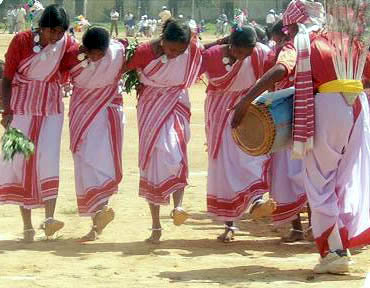Karma is a group dance. Generally this dance is celebrated for three days from the tenth day of the bright moon of the month of Bhadra to twelevth day. A small branch of Rengal or Halan tree is used as the Karma dal. Karma dal is brought to the puja pandal or karma gudi performing a special puja by the dehri accompanied with the beats of karma mandal and kubja. Then the karma daal is customarily planted and then follow the worship of karamsani and rituals. Karam or Karma literally means ‘fate’.
This pastoral dance is performed during the worship of the God or Goddess of fate (Karam Devta or Karamsani Devi), whom the people consider the cause of good and bad fortune. People with badiyan (personal wishes) came to urge their problems to karamsani and on behalf of karamsani, the dehri suggests them the solution at times. The dehri is believed as karamsani – the deity who bestows children and good crops-in person on that day.
The puja rituals are followed by the stories of karamsani. There are many stories of karamsani like the Dharam Karam brothers, Wealthy Saudagar, The Old Sadhab etc. And the completion of the story is followed by the dance.
The Karama dance continues till dawn. Group after group perform alternately throughout the night. The technique of the dance varies slightly from tribe to tribe. Tribes such as Kharias, Kisans and Oraons dance in a circular pattern, where men and women dance together. It is always headed by a leader and generally a male person leads the line. Only the best of dancers join next to or near him. Young girls and children join in at the tail-end to learn the steps.
When the dance becomes more vigorous, the dancers of the tail-end withdraw to let the true dancers show their skill. The dancers hold hands in different ways in different dances. Sometimes they simply hold hands and sometimes hands are placed on the neighbor’s waist band or are crossed.
It is the legs and the feets which play the principal role in the dance. The dance begins lightly with simple steps – forward and backward, left and right – then gradually the steps grow smaller and faster, enthusiasm accelerates until the dance reaches its height. Then it again returns the first steps as the music leads to give the dancers some rest. The dancers have no special costume for the occasion. They dance with their usual attires which they wear in their life.
In the morning the dehri carries the karma daal and visits each house of the village singing and dancing. Further the karma daal is ceremonially immersed in the village pond or river.
This dance is popular among tribes such as Binjhal, Kharia, Kisan and Kol.

